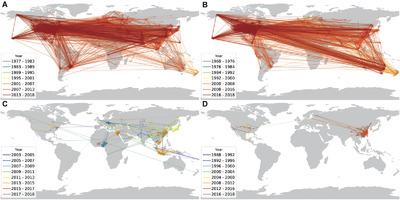当前位置:
X-MOL 学术
›
Integr. Zool.
›
论文详情
Our official English website, www.x-mol.net, welcomes your feedback! (Note: you will need to create a separate account there.)
Modeling analysis revealed the distinct global transmission patterns of influenza A viruses and their influencing factors
Integrative Zoology ( IF 3.3 ) Pub Date : 2020-07-10 , DOI: 10.1111/1749-4877.12469 Chaoyuan Cheng 1, 2 , Jing Li 2, 3 , Wenjun Liu 2, 3 , Lei Xu 4 , Zhibin Zhang 1, 5
Integrative Zoology ( IF 3.3 ) Pub Date : 2020-07-10 , DOI: 10.1111/1749-4877.12469 Chaoyuan Cheng 1, 2 , Jing Li 2, 3 , Wenjun Liu 2, 3 , Lei Xu 4 , Zhibin Zhang 1, 5
Affiliation

|
Influenza A virus has caused huge damage to human health and poultry production worldwide, but its global transmission patterns and influencing factors remain unclear. Here, by using the Nearest Genetic Distance Approach with genetic sequences data, we reconstructed the global transmission patterns of 4 most common subtypes of influenza A virus (H1N1, H3N2, H5N1, and H7N9) and analyzed associations of transmission velocity of these influenza viruses with environmental factors. We found that the transmission patterns of influenza viruses and their associations with environmental factors were closely related to their host properties. H1N1 and H3N2, which are mainly held by humans, are transmitted between regions at high velocity and over long distances, which may be due to human transportation via airplane; while H5N1 and H7N9, which are mainly carried by animals, are transmitted locally at short distances and at low velocity, which may be facilitated by poultry transportation via railways or high ways. H1N1 and H3N2 spread faster in cold seasons, while H5N1 spread faster in both cold and warm seasons, and H7N9 spread faster in wet seasons. H1N1, H3N2, and H5N1 spread faster in places with both high and low human densities. Our study provided novel insights into the global transmission patterns, processes, and management strategies for influenza under accelerated global change.
中文翻译:

建模分析揭示了甲型流感病毒不同的全球传播模式及其影响因素
甲型流感病毒已在全球范围内对人类健康和家禽生产造成巨大损害,但其全球传播模式和影响因素仍不清楚。在这里,通过使用遗传序列数据的最近遗传距离方法,我们重建了 4 种最常见的甲型流感病毒亚型(H1N1、H3N2、H5N1 和 H7N9)的全球传播模式,并分析了这些流感病毒的传播速度与环境因素。我们发现流感病毒的传播模式及其与环境因素的关联与其宿主特性密切相关。H1N1和H3N2主要由人类携带,在区域间高速、远距离传播,这可能与人类通过飞机运输有关;而 H5N1 和 H7N9,主要由动物携带,在当地短距离、低速传播,可通过铁路或公路运输家禽。H1N1和H3N2在寒冷季节传播较快,而H5N1在寒冷和温暖季节传播较快,H7N9在雨季传播较快。H1N1、H3N2 和 H5N1 在人口密度高和低的地方传播得更快。我们的研究为全球加速变化下流感的全球传播模式、过程和管理策略提供了新的见解。H1N1、H3N2 和 H5N1 在人口密度高和低的地方传播得更快。我们的研究为全球加速变化下流感的全球传播模式、过程和管理策略提供了新的见解。H1N1、H3N2 和 H5N1 在人口密度高和低的地方传播得更快。我们的研究为全球加速变化下流感的全球传播模式、过程和管理策略提供了新的见解。
更新日期:2020-07-10
中文翻译:

建模分析揭示了甲型流感病毒不同的全球传播模式及其影响因素
甲型流感病毒已在全球范围内对人类健康和家禽生产造成巨大损害,但其全球传播模式和影响因素仍不清楚。在这里,通过使用遗传序列数据的最近遗传距离方法,我们重建了 4 种最常见的甲型流感病毒亚型(H1N1、H3N2、H5N1 和 H7N9)的全球传播模式,并分析了这些流感病毒的传播速度与环境因素。我们发现流感病毒的传播模式及其与环境因素的关联与其宿主特性密切相关。H1N1和H3N2主要由人类携带,在区域间高速、远距离传播,这可能与人类通过飞机运输有关;而 H5N1 和 H7N9,主要由动物携带,在当地短距离、低速传播,可通过铁路或公路运输家禽。H1N1和H3N2在寒冷季节传播较快,而H5N1在寒冷和温暖季节传播较快,H7N9在雨季传播较快。H1N1、H3N2 和 H5N1 在人口密度高和低的地方传播得更快。我们的研究为全球加速变化下流感的全球传播模式、过程和管理策略提供了新的见解。H1N1、H3N2 和 H5N1 在人口密度高和低的地方传播得更快。我们的研究为全球加速变化下流感的全球传播模式、过程和管理策略提供了新的见解。H1N1、H3N2 和 H5N1 在人口密度高和低的地方传播得更快。我们的研究为全球加速变化下流感的全球传播模式、过程和管理策略提供了新的见解。



























 京公网安备 11010802027423号
京公网安备 11010802027423号